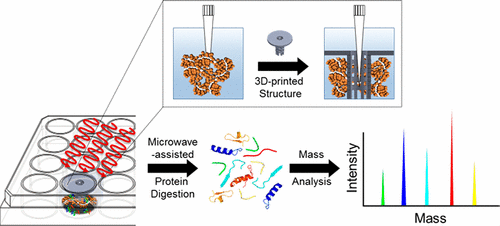当前位置:
X-MOL 学术
›
Anal. Chem.
›
论文详情
Our official English website, www.x-mol.net, welcomes your feedback! (Note: you will need to create a separate account there.)
Microwave-Assisted Protein Digestion in a Plate Well for Facile Sampling and Rapid Digestion
Analytical Chemistry ( IF 7.4 ) Pub Date : 2017-09-25 00:00:00 , DOI: 10.1021/acs.analchem.7b02169 Hyeonil Kim 1 , Han Sol Kim 1 , Dabin Lee 2 , Dongwon Shin 2 , Daeho Shin 3 , Jeongkwon Kim 2 , Jungbae Kim 1
Analytical Chemistry ( IF 7.4 ) Pub Date : 2017-09-25 00:00:00 , DOI: 10.1021/acs.analchem.7b02169 Hyeonil Kim 1 , Han Sol Kim 1 , Dabin Lee 2 , Dongwon Shin 2 , Daeho Shin 3 , Jeongkwon Kim 2 , Jungbae Kim 1
Affiliation

|
Protein digestion is one of the most important processes in proteomic analysis. Here, we report microwave-assisted protein digestion in a plate well, which allows for facile sampling as well as rapid protein digestion based on the combination of highly stable enzyme immobilization and 3D printing technologies. Trypsin (TR) was immobilized on polystyrene-based nanofibers via an enzyme coating (EC) approach. The EC with stabilized TR activity was assembled with the 3D-printed structure in the plate well (EC/3D), which provides two separated compartments for the solution sampling and the TR-catalyzed protein digestion, respectively. EC/3D can effectively prevent the interference of sampling by accommodating EC in the separated compartment from the sampling hole in the middle. EC/3D in the plate well maintained its protein digestion performance under shaking over 160 days. Microwave irradiation enabled the digestion of bovine serum albumin within 10 min, generating the MALDI-TOF MS results of 75.0% sequence coverage and 61 identified peptides. EC/3D maintained its protein digestion performance under microwave irradiation after 30 times of recycled uses. EC/3D in the plate well has demonstrated its potential as a robust and facile tool for the development of an automated protein digestion platform. The combination of stable immobilized enzymes and 3D-printed structures can be potentially utilized not only for the protein digestion, but also for many other enzyme applications, including bioconversion and biosensors.
中文翻译:

板孔中的微波辅助蛋白质消化,可轻松进行采样和快速消化
蛋白质消化是蛋白质组学分析中最重要的过程之一。在这里,我们报告了在板孔中进行微波辅助的蛋白质消化,该方法可根据高度稳定的酶固定和3D打印技术的组合,轻松进行采样并进行快速蛋白质消化。胰酶(TR)通过酶涂层(EC)方法固定在基于聚苯乙烯的纳米纤维上。具有稳定的TR活性的EC在板孔(EC / 3D)中以3D打印的结构进行组装,该板孔为溶液采样和TR催化的蛋白质消化分别提供了两个分隔的隔室。EC / 3D通过将EC从中间的采样孔容纳在分隔的隔间中,可以有效地防止采样干扰。平板中的EC / 3D在摇动160天后仍能很好地保持其蛋白质消化性能。微波辐射能够在10分钟内消化牛血清白蛋白,产生MALDI-TOF MS结果为75.0%的序列覆盖率和61种已鉴定的肽。经过30次循环使用后,EC / 3D在微波辐射下仍保持其蛋白质消化性能。平板孔中的EC / 3D展示了其作为开发自动化蛋白质消化平台的强大而便捷的工具的潜力。稳定的固定化酶和3D打印结构的组合不仅可以用于蛋白质消化,而且还可以用于许多其他酶应用,包括生物转化和生物传感器。产生MALDI-TOF MS的结果,结果为75.0%的序列覆盖率和61种已鉴定的肽段。经过30次循环使用后,EC / 3D在微波辐射下仍保持其蛋白质消化性能。平板孔中的EC / 3D展示了其作为开发自动化蛋白质消化平台的强大而便捷的工具的潜力。稳定的固定化酶和3D打印结构的组合不仅可以用于蛋白质消化,而且还可以用于许多其他酶应用,包括生物转化和生物传感器。产生MALDI-TOF MS的结果,结果为75.0%的序列覆盖率和61种已鉴定的肽段。经过30次循环使用后,EC / 3D在微波辐射下仍保持其蛋白质消化性能。平板孔中的EC / 3D展示了其作为开发自动化蛋白质消化平台的强大而便捷的工具的潜力。稳定的固定化酶和3D打印结构的组合不仅可以用于蛋白质消化,而且还可以用于许多其他酶应用,包括生物转化和生物传感器。平板孔中的EC / 3D展示了其作为开发自动化蛋白质消化平台的强大而便捷的工具的潜力。稳定的固定化酶和3D打印结构的组合不仅可以用于蛋白质消化,而且还可以用于许多其他酶应用,包括生物转化和生物传感器。平板孔中的EC / 3D展示了其作为开发自动化蛋白质消化平台的强大而便捷的工具的潜力。稳定的固定化酶和3D打印结构的组合不仅可以用于蛋白质消化,而且还可以用于许多其他酶应用,包括生物转化和生物传感器。
更新日期:2017-09-25
中文翻译:

板孔中的微波辅助蛋白质消化,可轻松进行采样和快速消化
蛋白质消化是蛋白质组学分析中最重要的过程之一。在这里,我们报告了在板孔中进行微波辅助的蛋白质消化,该方法可根据高度稳定的酶固定和3D打印技术的组合,轻松进行采样并进行快速蛋白质消化。胰酶(TR)通过酶涂层(EC)方法固定在基于聚苯乙烯的纳米纤维上。具有稳定的TR活性的EC在板孔(EC / 3D)中以3D打印的结构进行组装,该板孔为溶液采样和TR催化的蛋白质消化分别提供了两个分隔的隔室。EC / 3D通过将EC从中间的采样孔容纳在分隔的隔间中,可以有效地防止采样干扰。平板中的EC / 3D在摇动160天后仍能很好地保持其蛋白质消化性能。微波辐射能够在10分钟内消化牛血清白蛋白,产生MALDI-TOF MS结果为75.0%的序列覆盖率和61种已鉴定的肽。经过30次循环使用后,EC / 3D在微波辐射下仍保持其蛋白质消化性能。平板孔中的EC / 3D展示了其作为开发自动化蛋白质消化平台的强大而便捷的工具的潜力。稳定的固定化酶和3D打印结构的组合不仅可以用于蛋白质消化,而且还可以用于许多其他酶应用,包括生物转化和生物传感器。产生MALDI-TOF MS的结果,结果为75.0%的序列覆盖率和61种已鉴定的肽段。经过30次循环使用后,EC / 3D在微波辐射下仍保持其蛋白质消化性能。平板孔中的EC / 3D展示了其作为开发自动化蛋白质消化平台的强大而便捷的工具的潜力。稳定的固定化酶和3D打印结构的组合不仅可以用于蛋白质消化,而且还可以用于许多其他酶应用,包括生物转化和生物传感器。产生MALDI-TOF MS的结果,结果为75.0%的序列覆盖率和61种已鉴定的肽段。经过30次循环使用后,EC / 3D在微波辐射下仍保持其蛋白质消化性能。平板孔中的EC / 3D展示了其作为开发自动化蛋白质消化平台的强大而便捷的工具的潜力。稳定的固定化酶和3D打印结构的组合不仅可以用于蛋白质消化,而且还可以用于许多其他酶应用,包括生物转化和生物传感器。平板孔中的EC / 3D展示了其作为开发自动化蛋白质消化平台的强大而便捷的工具的潜力。稳定的固定化酶和3D打印结构的组合不仅可以用于蛋白质消化,而且还可以用于许多其他酶应用,包括生物转化和生物传感器。平板孔中的EC / 3D展示了其作为开发自动化蛋白质消化平台的强大而便捷的工具的潜力。稳定的固定化酶和3D打印结构的组合不仅可以用于蛋白质消化,而且还可以用于许多其他酶应用,包括生物转化和生物传感器。


























 京公网安备 11010802027423号
京公网安备 11010802027423号